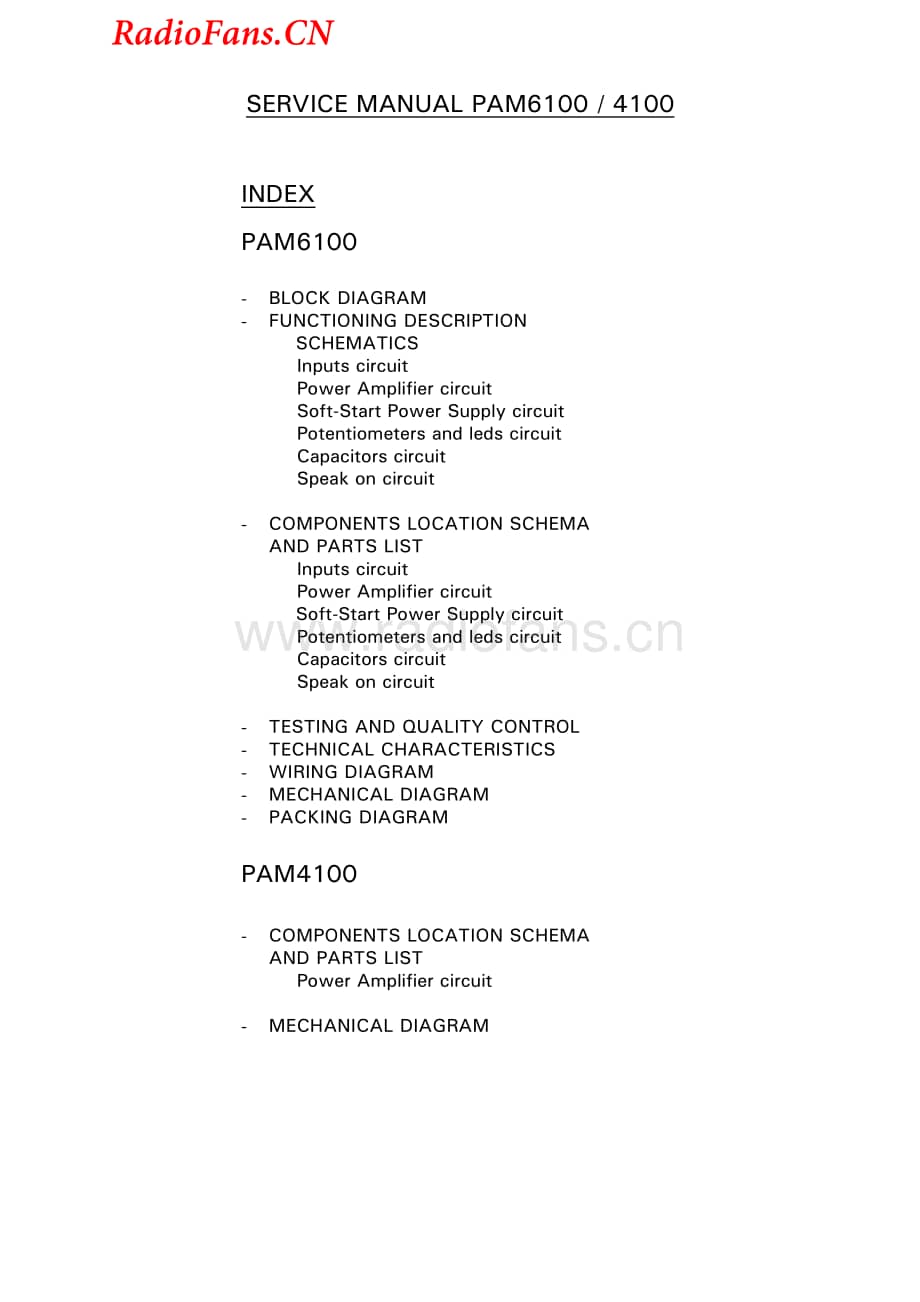《Ecler-PAM6100-pwr-sm维修电路图 手册.pdf》由会员分享,可在线阅读,更多相关《Ecler-PAM6100-pwr-sm维修电路图 手册.pdf(109页珍藏版)》请在收音机爱好者资料库上搜索。
1、 SERVICE MANUAL SIGNAL PROTECT THERMALTHERMAL BRIDGED PROTECT 6 100 1 2 4 3 5 9 8 SIGNAL CLIP 7 1 2 0 3 4 5 9 10 8 CLIP 6 7 ON OFF SWITCHING POWER MOSFET AMPLIFIER CHANNEL ICHANNEL II THERMAL PROTECT SIGNAL PROTECT BRIDGED100 1 2 9 8 SIGNAL CLIP 1 2 010 9 8 CLIP THERMAL 64 3 5 73 5 46 7 ON OFF SWITC
2、HING POWER MOSFET AMPLIFIER CHANNEL ICHANNEL II RadioFans.CN SERVICE MANUAL PAM6100 / 4100 INDEX PAM6100 - BLOCK DIAGRAM - FUNCTIONING DESCRIPTION SCHEMATICS Inputs circuit Power Amplifier circuit Soft-Start Power Supply circuit Potentiometers and leds circuit Capacitors circuit Speak on circuit - C
3、OMPONENTS LOCATION SCHEMA AND PARTS LIST Inputs circuit Power Amplifier circuit Soft-Start Power Supply circuit Potentiometers and leds circuit Capacitors circuit Speak on circuit - TESTING AND QUALITY CONTROL - TECHNICAL CHARACTERISTICS - WIRING DIAGRAM - MECHANICAL DIAGRAM - PACKING DIAGRAM PAM410
4、0 - COMPONENTS LOCATION SCHEMA AND PARTS LIST Power Amplifier circuit - MECHANICAL DIAGRAM RadioFans.CN SHUTDOWN SHUTDOWN INPUT CIRCUIT S.P. OFF CH 2 S.P. 20Hz HIGH PASS FILTER OFF 40Hz 30Hz 20Hz 30Hz 40Hz VCA -Vref VOLUME AC DETECT BRIG MODULES OPTIONAL BRIG PROTECT OUTPUT CONTROL ANTICLIP AND TIME
5、R PROTECTION RELAY OUTPUT CLIP HIGH PASS FILTER CH 1 THERMAL PROCESSOR THERMAL PROCESSOR THERMAL PROTECT FAN CONTROL THERMAL OPTIONAL STEREO MODULES PROBE TRANSFORMER PROBE MODULE THERMAL -Vref VCA THERMAL ADJ 0dB CONTROL VOLUME FAN CROWBAR POWER MODUL CIRCUIT OUT 2 POWER MODUL CIRCUIT LEVEL CONVERT
6、ER DRIVERMOSFET N OVERLOAD LOW SIDE -Vcc LEVEL CONVERTER FEEDBACK DRIVERMOSFET N MIRROR WILSON CURRENT ZOBEL DC PROTECT HIGH SIDE OVERLOAD OUT 1 +Vcc +Vcc +15V RadioFans.CN author:Queraltdate:010418project:EP04-99product:PAM4/6100 approved: num:52.0010version:01.00 title: FUNCTIONING DESCRIPTION ECL
7、ER EPO4-99 Power Module. Functioning description. Due to the high power level required on the output load, the amplifier final stages structure differs from the design used untill now. This is due to the breakdown voltage limit on P-channel MosFETs, wich is 200V. This final stage is formed by severa
8、l shunted MosFETs, where those of the positive branch are common-drain configured, and the negative branch are mounted in common-source configuration. The systems controlling device is a NE5534-type operational amplifier, wich is internally compensated in order to obtain gain levels equal or higher
9、than three. The amplifiers feedback is given by a resistor and a capacitor associated to the operational amplifiers non inverting input. Transistors BF587 and BF588 are common-base configured, forming a current supply structure. This specific transistor type is used because of the higher Vce voltage
10、 level required by this design. They perform simultaneously two functions: they polarize the MosFETs gate-source junctions, keeping them on the conducting edge, and they tranfer the OpAmps output voltage variations referred to signal ground. The signal variations normally reflected by Q107 and refer
11、red to the positive power supply, are now needed to be floating variations, and referred to the outputs. This function is done by Q109-110 (BF588), wich are mounted formig a Wilson-type mirror current supply. This mirror current supply transfers all of the current variations detected while descendin
12、g through Q109s collector, to similar variations on Q110s collector also downward current. Resistors R167 and R174 are used to balance the current mirror, in order to avoid the use of transistors with forcibly the same beta value. C138 and C141 suppress their resistance when high frequency signal is
13、 processed. Diodes D126 and D127 avoid the transistors to get saturated, and R171 eliminates the loads on BF588s bases (Baker Circuit). The system requires about 12Vdc additional voltage upon the usual Vcc level, this allows a correct saturation and a symetric clipping at the higher MosFETs. The cor
14、rect polarization current value is adjusted by a 4K7 potentiometer connected to the BF transistors emitter. This adds an additional current to the current source output on th BF transistors loading resistors. In order to maintain the appropiate stand-by current level against varying temperature cond
15、itions, BD437-type transistors are used. As they have a particular temperature- depending base-emitter voltage curve, this voltage is used to keep a correct voltage reference for the current supply. As the temperature rises, the reference voltage level decreases, the gate-source voltage also decreas
16、es and, finally, the bias current also decreases. 52-0010-0100 EP04-99 Angls.xls 1 of 3 RadioFans.CN Transistors Q111 and Q112, and their corresponding twins at the lower branch, form a current-buffering circuit wich allows a fast charge and discharge of the power MosFETs gates. The Zobel circuit, a
17、 resistance-capacitance-inductance formed network associated to the amplifiers ouput, tries to keep the amplifiers output load impedance constant no matter wich load value is conected to the output, or wich frequency is processed, in order to avoid phase shifts on the feedback signal. To avoid the p
18、resence of DC voltage on the output, a diac-triac based system is used, wich shorts the output to signal ground in case the DC level reaches the diacs triggering value. To avoid this to happen when processing correct signal (sine waveform, music.), the diac obtains its reference level from a filteri
19、ng network formed by a 100K resistor and a 1mF capacitor. The protections circuitry overhauls the MosFETs power consumption. Basically, this circuitry consists of two important sections: MosFETs Id current monitoring, and MosFETs Vds value detection. When the MosFETs Id level rises above a certain l
20、evel, transistor Q119 (controlling transistor) conducts and decreases the BF transistors loading resistance, thus reducing also their gate-source voltage and, finally, lowering the Id current value. This system is helped by a delayed performance, due to the associated circuitry to Q145 and C174. Thi
21、s capacitor starts to charge when a current level above the allowed value is detected, and the protection starts. The greater is the capacitors charge level, the higher is also the voltage applied to Q119 controlling transistors base, increasing its conduction and, consequently, reducing the gate-so
22、urce voltage and thus the Id current value. This system uses a feedback network. The delay used is necessary to avoid clipping the processed signals dynamic range, wich should result in the typical clipping noise. In the negative branch, the protection circuitry is associated to control transistor Q
23、120. In case the overcurrent is not ocassional, and persists, after a period of time between 4 and 10 seconds (determined by R142 and C124), the system switches back to Stand- by mode, due to a system-reset. This is done by an optocoupler (IC113) associated to the negative branch protection circuitr
24、y. When protections get activated, IC113 gradually charges C124 untill a 40106-type Schmidt trigger gate switches over . If the problem persists, this cycle is repeated. STANDBY CIRCUITRY. This circuit maintains the Output shutdown relay closed for about 10 seconds, and thus annulates any current th



- 配套讲稿:
如PPT文件的首页显示word图标,表示该PPT已包含配套word讲稿。双击word图标可打开word文档。
- 特殊限制:
部分文档作品中含有的国旗、国徽等图片,仅作为作品整体效果示例展示,禁止商用。设计者仅对作品中独创性部分享有著作权。
- 关 键 词:
- Ecler-PAM6100-pwr-sm维修电路图 手册 Ecler PAM6100 pwr sm 维修 电路图
 收音机爱好者资料库所有资源均是用户自行上传分享,仅供网友学习交流,未经上传用户书面授权,请勿作他用。
收音机爱好者资料库所有资源均是用户自行上传分享,仅供网友学习交流,未经上传用户书面授权,请勿作他用。
 Ecler-PAM6100-pwr-sm维修电路图 手册.pdf
Ecler-PAM6100-pwr-sm维修电路图 手册.pdf



 Crown-XLS202-pwr-sch维修电路图 手册.pdf
Crown-XLS202-pwr-sch维修电路图 手册.pdf


